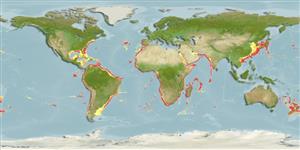Пластиножаберные (акулы и скаты) (sharks and rays) >
Squaliformes (Sleeper and dogfish sharks) >
Etmopteridae (Lantern sharks)
Etymology: Etmopterus: Greek, ethmos, -ou = sieve or ethmoides bone + Greek, pteron = wing, fin (Ref. 45335).
More on author: Lowe.
Environment: milieu / climate zone / depth range / distribution range
экология
морской батидемерсальный; мигрирует в океане (Ref. 51243); пределы глубины 0 - 1120 m (Ref. 106604), usually 400 - 700 m (Ref. 36731). Deep-water; 45°N - 55°S, 98°W - 171°W
Western Atlantic: northern Gulf of Mexico and southern Brazil to Argentina (Ref. 247, 6871); one specimen collected off the Guianas (Ref. 13608). Eastern Atlantic: Portugal to Namibia (Ref. 247, 127434). Also in oceanic waters between Argentina and South Africa (Ref. 247). Western Indian Ocean: South Africa, and Arabian Sea (Ref.85183). Western Pacific: Australia (Ref. 6871), New Zealand (Ref. 26346), and Japan (Ref. 247). Southeast Pacific: Amber Seamount, Nasca and Sala-y-Gomez.
Length at first maturity / Size / Вес / Возраст
Maturity: Lm 42.5, range 38 - 47 cm
Max length : 50.0 cm TL самец/пол неопределен; (Ref. 36731)
колючие лучи спинного плавника (общее число) : 2; колючие лучи анального плавника: 0. Bladelike unicuspidate teeth in lower jaw and teeth with cusps and cusplets in upper jaw, relatively short snout, low, truncated denticles (Ref. 247). Blackish brown dorsally, with an obscure broad black mark running above, in front and behind pelvic fins (Ref. 247).
Found on or near the bottom of continental and insular slopes at depths from 275 to 1,000 m (possibly to 2,000 m); also oceanic in the south Atlantic from the surface to 710 m (Ref. 6871), possibly as deep as 1998 m (Ref. 58302). Feeds on fish eggs, lanternfish, squid, and other small dogfish (Ref. 5578). Ovoviviparous (Ref. 205). Utilized dried salted for human consumption and for fishmeal (Ref. 247).
Life cycle and mating behavior
половая зрелость | размножение | нерест | икра | Fecundity | личинки
Ovoviviparous (Ref. 247). Distinct pairing with embrace (Ref. 205).
Compagno, L.J.V., 1984. FAO Species Catalogue. Vol. 4. Sharks of the world. An annotated and illustrated catalogue of shark species known to date. Part 1 - Hexanchiformes to Lamniformes. FAO Fish. Synop. 125(4/1):1-249. Rome, FAO. (Ref. 247)
Статус Красного Списка МСОП (Ref. 130435: Version 2024-1)
Угроза для людей
Harmless
Использование человеком
рыболовство: не имеет хозяйственного значения
дополнительная информация
инструменты
Специальные отчеты
Скачать в формате XML
ресурсы в Интернет
Estimates based on models
Preferred temperature (Ref.
123201): 5.3 - 13.6, mean 8.9 °C (based on 409 cells).
Phylogenetic diversity index (Ref.
82804): PD
50 = 0.5000 [Uniqueness, from 0.5 = low to 2.0 = high].
Bayesian length-weight: a=0.00347 (0.00226 - 0.00532), b=3.05 (2.92 - 3.18), in cm total length, based on LWR estimates for this species & Genus-body shape (Ref.
93245).
Trophic level (Ref.
69278): 4.2 ±0.4 se; based on diet studies.
устойчивость к внешним воздействиям (Ref.
120179): низкий, минимальное время удвоения популяции 4.5-14 лет (Fec assumed to be <100).
Fishing Vulnerability (Ref.
59153): Moderate vulnerability (40 of 100).
Nutrients (Ref.
124155): Calcium = 11 [2, 59] mg/100g; Iron = 0.361 [0.083, 1.174] mg/100g; Protein = 19.3 [16.7, 21.6] %; Omega3 = 0.335 [0.121, 1.064] g/100g; Selenium = 12.6 [3.9, 37.7] μg/100g; VitaminA = 19 [4, 88] μg/100g; Zinc = 0.336 [0.161, 0.660] mg/100g (wet weight);
